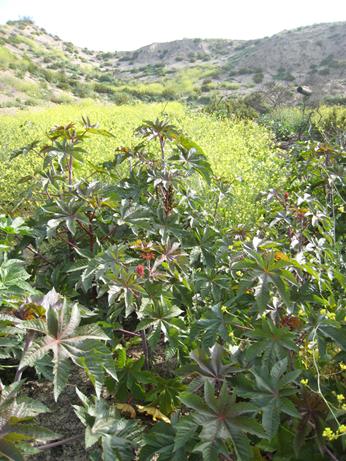Invasive Plants and Wildland Health

Invasive castor bean and mustard growing in Griffith Park after a fire.
Most plants don’t escape our yards and gardens, but the handful that do can cause serious problems. Animals, wind, and water move plants and seeds far from where they were planted. Once established in natural areas, these plants displace native vegetation and greatly reduce wildlife diversity. Invasive plants also fuel wildfires, contribute to soil erosion, clog streams and rivers, and increase flooding. Poor maintenance of cleared areas can promote their spread. Because they thrive in disturbed soils, improper clearance or over-clearance often leads to a landscape dominated by invasive plants. These plants can produce more fuels than native vegetation, increasing the potential for ignition.
When choosing plants for your fire-safe landscape, you can help protect the health of neighboring wildlands by avoiding invasive species. Several of the worst invasive species are described on this web site, but you can find a full list, developed by the California Invasive Plant Council, at
www.cal-ipc.org. Remember when buying plants to make sure to check the scientific name so that you are getting the species you want!
For information on selected plants that cause ecological and fire-related problems, click here
SAFE_Landscapes_SoCal_Problem_Plants_09-29-09
PlantRight and Don't Plant a Pest offer some great alternatives to invasive species.
